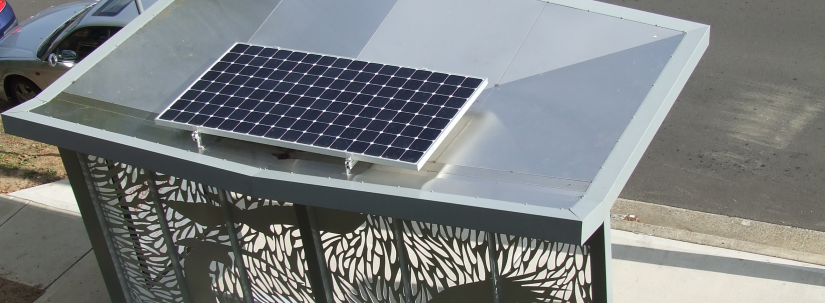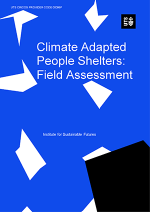Bus shelters are seldom designed with ‘shelter’ in mind. Their location and construction is predicated on a model that focuses on the placement of advertising, safety and the operational needs of transport authorities - often overlooking the implications of increasing urban heat, and its impact on vulnerable communities.
The Climate Adapted People Shelters (CAPS) project has initiated collaborative, design-led approaches to reimagining the place and function of bus shelters, specifically in response to conditions of increasing urban heat and extreme weather events in Western Sydney.
From user engagement through an open innovation design completion to monitoring and evaluation in a real world environment of the constructed shelter. The following link to 360 imagery transports you to demonstrate the design features of CAPS versus a traditional bus shelter.
Explore Penrith in Virtual Reality
Why is designing for 'shelter' important?
Over the past 100 years, heat waves have caused more deaths in Australia than any other natural hazard.
The Western Sydney area is projected to experience up to seven additional days above 35°C per year by 2030, placing exposed communities at heightened risk –including Sydney's 600,000 daily bus users.
By 2031, Sydney’s bus users will make in excess of 1.3 million journeys per day, with buses being the most accessible form of public transport for many of Sydney’s most vulnerable community members.
As a consequence, the NSW State Transit Bus Infrastructure Guide advises that bus shelters should provide a comfortable, convenient, reliable, and safe service that is accessible to all, and further advises that bus shelter designers keep in mind the requirements of more vulnerable members of the community, such as the elderly; mobility, vision and hearing impaired people; and people with young children, strollers and prams, who are most heavily dependant on public transport services, and most adversely affected by the impacts of urban heat.
The Climate Adapted People Shelters (CAPS) project, a collaboration between the Institute for Sustainable Futures, U.Lab and the Centre for Management and Organisation Studies, the NSW Climate Adaptation Research Hub and the Institute for Culture and Society at Western Sydney University (WSU) was developed, with the aim of co-creating and researching the implications for climate adapted and smart urban infrastructure designs, with a focus on re-imagining the old bus shelter.
To achieve this aim, CAPS was planned as an open innovation design competition, with strong use of methods of human centred design.
How CAPS works
The CAPS project was delivered in three stages:
Stage 1 of the project, beginning in February 2016, consisted of planning and completing the co-design of bus shelters in four NSW local government areas: Ashfield, Canterbury, Parramatta and Penrith.
Stage 2 of the project, beginning in late 2016, involved the construction of a prototype shelter in Penrith City Council. This stage utilised a prototype of the Modus Shelter, developed by MM Creative. This shelter utilises insulated aluminium to minimise the absorption of heat on the shelter's roof, a larger overhang to provide more shade at hot times of day, as well as a solar PV system to allow for LED lightning of the shelter, and anti-graffiti coating to maintain the improved aesthetic appearance of the shelter.
Stage 3 of the project, conducted in late 2017, involved a review of the thermal performance of the CAPS, in conjunction with a review of the current use and potential of smart infrastructure technologies within bus shelters, and a detailed account of the design process.
How successful have the CAPS shelters been in reducing urban heat impacts?
The success of the CAPS shelters was assessed using three criteria, assessed during heatwave conditions (maximum temperatures of 30-40C without rain):
- the thermal performance of the new shelter, assessed through "button" data loggers installed in the existing and new shelters
- spot readings of ambient temperature, relative humidity and wind speed were recorded hourly (0900 – 5pm) as well as surface temperatures of the ground, seat, and roof of each shelter
- the social acceptance for users, and any difficulties observed for transport operators, assessed through the observation of user behaviour and surveys of bus stop users.
The data loggers showed that while ground temperatures were similar for existing bus shelters and the newly installed CAPS shelters, the roof surface temperature of the CAPS shelter was up to 15C lower during peak temperature events in the middle of the day.
It also showed that while the CAPS seats, made of the same metal fabrication material as existing bus shelter seats, warmed faster than existing seats, they also cooled significantly faster in periods of heat.
The public response to the CAPS prototype was overwhelmingly positive. Users mentioned the improved thermal comfort, the modern aesthetic design and the additional protection from direct sun exposure lead to an improved user experience.
The seating design resulted in mixed responses, due to differences in the hardness and shape of these seats. Importantly, users within disadvantaged groups noted that the CAPS seats eased the transition between sitting and standing through the use of chair handles integrated into the seating design.
In conclusion, the findings from implementing the CAPS prototype shelter show:
- passive design elements of an open structure can be used to influence radiation, temperature and user thermal comfort
- users visibly adapt their behaviour to optimise their thermal comfort
- the elements of design most important to modification of temperature and user behaviour were the provision of shade and seating with respect to the movement of shade throughout the day.
Researchers
-
Associate Professor and Research Director
-
Adjunct Fellow
-
Research Principal
-
Associate Professor of Strategy and Innovation and Director of Entrepreneurship, UTS Business School
Years
- 2015-2019
Client
- Penrith City Council
Funded by
- NSW Office of Environment and Heritage, NSW Environmental Trust
Wider program
- Building Resilience to Climate Change grants scheme







